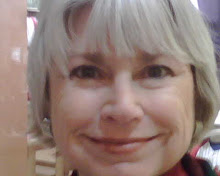After years of driving I-40, really Kyle's first trek was at the age of 5 and we had made several laps by then, we finally stopped at Meteor Crater. This natural landmark is a mere 6m south of the freeway; we should have solved this mystery years ago.
Yesterday we headed over to Winslow to see the town made famous by the Eagles in the 1970's. Turns out that Winslow was the largest town in northern Arizona when the Sante Fe Railroad built a depot and hotel in the 1930's. The hacienda style mansion was designed and built by Mary Colter, a rare female architect at that time. She took every detail to heart and despite a butchering in the 1960's, the labor of love is still impressive. Stars of the Golden Age of film flocked to this locale to rest, play and tour on day trips.
We really did enjoy seeing the restoration of La Posada. The atmosphere is restful and a showcase for local artists. The new owner has taken great pride in showing off the old photos and the new efforts to bring back the glory. Open windows and doors provided a breezy cool on a early June day with a high of 86. The hotel reviews that I read were not great, but it is definitely a work in progress.
We then spent a quick 5 minutes to pay homage to rock music by visiting a corner of old Route 66 that now boasts a guitar playing guy permanently enshrined across from the Standing On the Corner tourist trap. We walked and then drove around to find a cafe in town. From what we saw, La Posada was the only option, we didn't even find a McDonald's. Street construction did not help our efforts to see the town or the town's efforts to keep tourists from leaving.
This morning we visited the meteor crater, a family owned landmark, museum, theater and gift shop. Daniel M. Barringer, a New York mining engineer, bought the land with the belief that it was caused by a meteor and that he could mine the out-of-this-world ore. Did he ever realize that he was only half right? His descendants were persuaded to join forces with a local family to open it to the public. They have been mining the tourist dollar since the 1940's.
The compound is well done and informative. A guide gave a really good presentation and fielded every question. A short movie also helps to explain the event, which happened about 50,000 years ago. This hole in the ground, about a mile wide and 550 feet deep, was caused by a rock about 50 yards in diameter. It dove deep into the ground, hit the water table and exploded to the tune of ten times the magnitude of Hiroshima. It created a debris perimeter of 7 miles. The largest known rock is on display. It is about the size of a doll house and weighs slightly less than a small car. No one knows how much asteroid liter has walked away from here over the years. Most of the remaining debris is dirt sized or smaller.
Scientists and astronauts use and explore this crater. Tourists don't. You can see it from a large window in the museum or brave the winds and walk the sidewalks to several decks. There is a person statue in the bottom that is visible with the telescope, but not unaided. It is a shock to be told that it is there after looking down at it for several minutes completely unaware.
We are very glad that we finally made this stop, anticlimactic after so many years of "we'll go see that one day." Well, this was the day and we can check it off the list.
Subscribe to:
Post Comments (Atom)

No comments:
Post a Comment